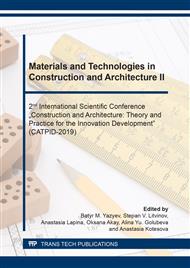p.505
p.510
p.515
p.521
p.529
p.535
p.542
p.551
p.556
Local Stability of Beams with a Flexible Wall with the Concentrated Force Action
Abstract:
The article considers the local stability of hinged supported beams with a flexible wall, supported by paired stiffeners on the supports and loaded with a concentrated force in the middle of the span. To prevent the loss of stability of the wall from compression, another edge was installed in the area of application of force. The materials considered as beams were steel, aluminum, and stainless steel. In this work, the beam material is steel C345. The study was conducted by analyzing the requirements of the Code of Practice for beams with a flexible wall in terms of the stability loss caused by the two types of deformations - shear and bending. By means of small simplifications, the requirements of the Code of Practice have been transformed into empirical dependencies convenient for practical calculations for estimating the critical loads on the beam. The finite element method with ANSYS software was used as an effective analysis tool. It has been established that in some cases the cause of loss of stability is a shift, and in others - a bend. A criterion for changing the forms of buckling was also obtained. The calculation results for the obtained dependences are in satisfactory agreement with the FEM and experimental data.
Info:
Periodical:
Pages:
529-534
Citation:
Online since:
December 2019
Authors:
Keywords:
Price:
Сopyright:
© 2020 Trans Tech Publications Ltd. All Rights Reserved
Share:
Citation:


